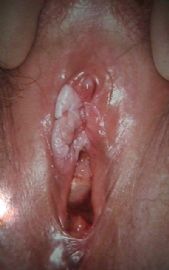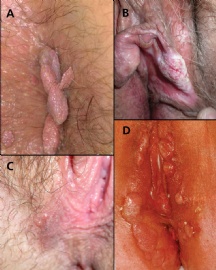| 图片: | |
|---|---|
| 名称: | |
| 描述: | |
- ‘外阴白斑’活检1例(VINIII第二次手术标本病理会诊报告 2010-09-29)
-
wangqiupeng 离线
- 帖子:148
- 粉蓝豆:1
- 经验:492
- 注册时间:2010-05-05
- 加关注 | 发消息
-
本帖最后由 于 2010-09-14 20:00:00 编辑
| 以下是引用wy1992在2010-9-13 23:43:00的发言: PAGED'S disease |
谢谢wy1992老师提供的思路。 

Review for Extramammary Paget's Disease
Extramammary Paget’s disease (EMPD), also Extramammary Paget disease, is a rare, slow-growing, usually non-invasive intraepithelial (in the skin) adenocarcinoma outside of the mammary gland and includes Paget's disease of the vulva and the extremely rare Paget's disease of the penis.
Extramammary Paget’s disease involves primarily the epidermis but occasionally extends into the underlying dermis.It has a predilection for apocrine gland bearing areas, mostly the perineum, vulva, axilla, scrotum, and penis.
Prognosis and comorbity
Extramammary Paget's disease is usually seen in isolation and is not usually associated with an underlying invasive malignancy. This is unlike Paget's disease of the breast, which is almost always associated with an underlying invasive malignancy, i.e. breast cancer (e.g. mammary ductal carcinoma).
Signs and symptoms
Signs and symptoms are a skin lesion often mistaken as eczema that may be itchy or painful. A biopsy will establish the diagnosis. The histology of the lesion is the same as for Paget's disease of the breast.
Types
Paget's disease of the vulva, a rare disease, may be a primary lesion or associated with adenocarcinoma originating from local organs such as the Bartholin gland, the urethra, or the rectum and thus be secondary. Patients tend to be postmenopausal.
Paget's disease of the penis may also be primary or secondary and is even rarer than genital Paget’s disease in women. At least one case has been misdiagnosed as Bowen's disease.Isolated Paget's disease of the penis is extremely rare.
Primary disease
It is important to exclude that the lesion is associated with another cancer. Primary disease is usually treated by surgical excision.
History
James Paget described Paget's disease of the nipple in 1874. Radcliffe Crocker reported the first case of EMPD in 1889 when he described a patient with a skin lesion affecting the penis and scrotum, the findings of which were identical to those described by Paget.
Micrograph of extramammary Paget's disease. H&E stain.
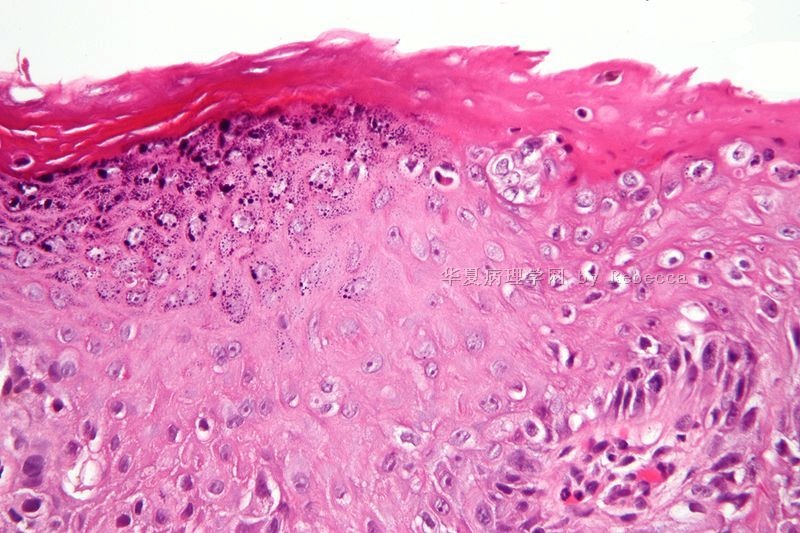
名称:图1
描述:图1

- 三十功名尘与土,八千里路云与月。
-
本帖最后由 于 2010-09-28 21:30:00 编辑
| 以下是引用wfbjwt在2010-9-14 18:22:00的发言: 鲍温病、派杰病、浅表恶黑鉴别。 |

 wfbjwt
wfbjwt
Review for Bowen's Disease
Bowen's disease (BD) (also known as "squamous cell carcinoma in situ"[1]:655) is a neoplastic skin disease, it can be considered as an early stage or intraepidermal form of squamous cell carcinoma. It was named after Dr John T. Bowen, the doctor who first described it in 1912. Erythroplasia of Queyrat is a form of squamous cell carcinoma in situ arising on the glans or prepuce, possibly induced by HPV.[2]
Causes
Causes of BD include solar damage, arsenic, immunosuppression (including AIDS), viral infection (human papillomavirus or HPV) and chronic skin injury and dermatoses.
Signs and symptoms
Bowen's disease typically presents as a gradually enlarging, well demarcated erythematous plaque with an irregular border and surface crusting or scaling. BD may occur at any age in adults but is rare before the age of 30 years - most patients are aged over 60. Any site may be affected, although involvement of palms or soles is uncommon. BD occurs predominantly in women (70-85% of cases). About 60-85% of patients have lesions on the lower leg, usually in previously or presently sun exposed areas of skin.
This is a persistent progressive non-elevated red scaly or crusted plaque which is due to an intraepidermal carcinoma and is potentially malignant. The lesions may occur anywhere on the skin surface or on mucosal surfaces. Freezing, cauterization or diathermy coagulation is often effective treatment.
Histology
Bowen's disease is essentially equivalent to squamous cell carcinoma in situ. Atypical squamous cells proliferate through the whole thickness of the epidermis. The entire tumor is confined to the epidermis and does not invade into the dermis. The cells in Bowen's are often highly atypical under the microscope, and may in fact look more unusual than the cells of some invasive squamous cell carcinomas.
Additional images
onmouseover="showMenu(this.id, 0, 1)">

- 三十功名尘与土,八千里路云与月。
-
nfykdx2008 离线
- 帖子:734
- 粉蓝豆:28
- 经验:761
- 注册时间:2010-09-08
- 加关注 | 发消息

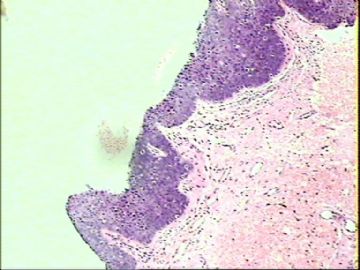
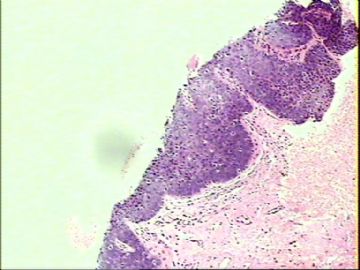

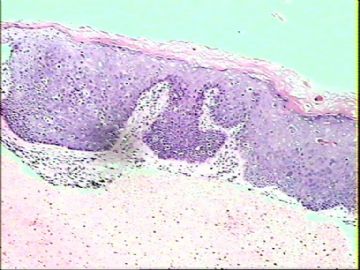
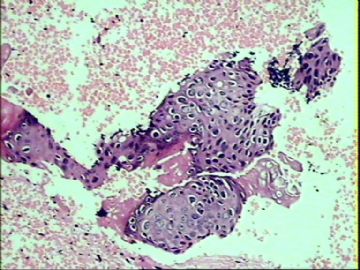
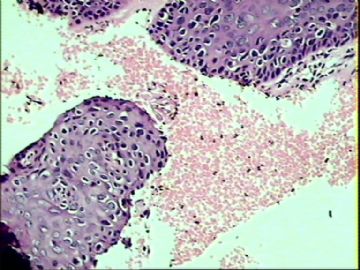
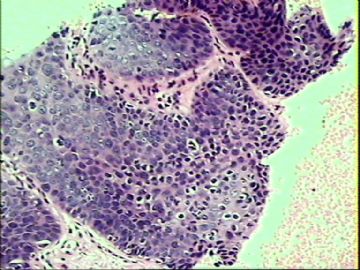

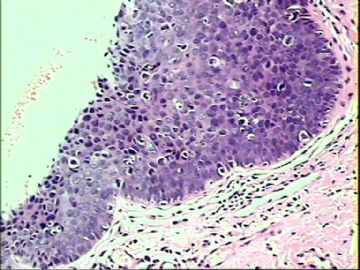
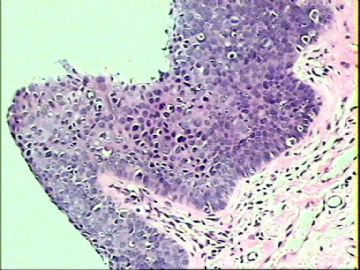
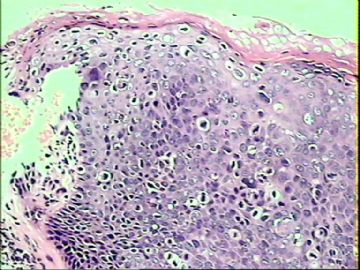
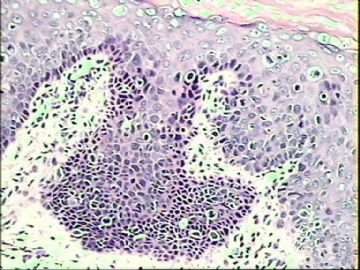


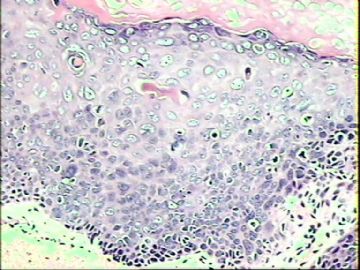
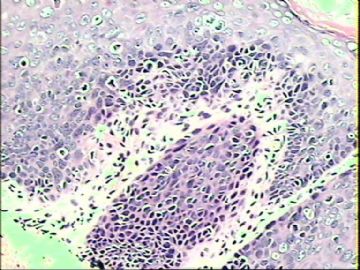




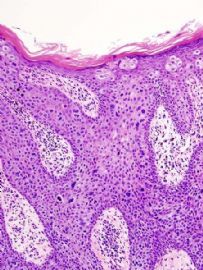
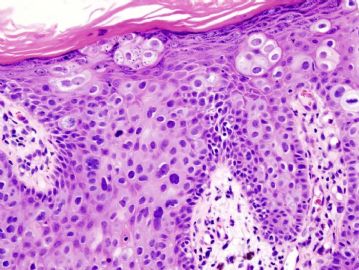
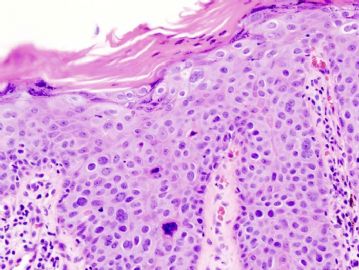





 学习了
学习了 